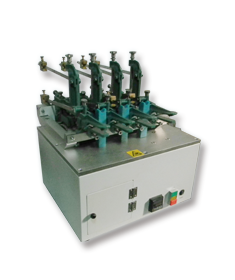What is the principle of Oscillatory Abrasion Tester?
Oscillatory Abrasion Tester, uses the oscillating cylinder method to measure the abrasion resistance of woven textiles. The test specimen is subjected to unidirectional friction under varying pressure, tension, and abrasion. After testing, the specimen is evaluated by fracture, percent loss at break, and visual change. Oscillating cylinder abrasion testers are particularly suitable for evaluating the wear resistance of automotive upholstery and synthetic leather.
Abrasion testers play a vital role in materials science, quality control, and product development. They simulate the degradation of materials due to friction and wear in actual use, providing critical data for material selection, improvement, and product quality assessment. A thorough understanding of their basic operating principles and advantages is crucial for fully utilizing the equipment's capabilities.
An oscillating abrasion tester, also known as a Wyzenbeek abrasion tester, measures the wear resistance of fabrics when rubbed against a standard abrasive or wire mesh screen in a back-and-forth motion on a curved surface. It is particularly suitable for evaluating the abrasion resistance of fabrics used in the automotive and furniture industries. This instrument complies with US standards and features four abrasion heads and an electronic counter to control the operating cycle.
Basic Working Principles of a Wear Tester
(I) Relative Motion of the Friction Pair
The key lies in constructing a specific friction pair to generate relative motion between the specimen and the counter-wearing part. Common forms of relative motion include rotational motion, reciprocating motion, or a combination of the two. For example, in a rotational wear tester, the specimen is fixed in a specific fixture while the counter-wearing part rotates at high speed around the same axis. The contact between the two surfaces generates friction, gradually causing wear on the specimen surface. In a reciprocating wear tester, the counter-wearing part slides back and forth along a predetermined track, continuously interacting with the specimen surface, simulating the wear conditions of components such as pistons and cylinder liners.
(II) The Role of the Loading System
To more realistically reproduce the wear conditions experienced by the material, the tester is equipped with a loading system. This system can apply a load perpendicular to the specimen surface, and the load magnitude can be precisely adjusted. When the load is applied, it increases the normal pressure between the specimen and the counter-wearing part, thereby affecting the magnitude of the friction. Different materials often exhibit different wear rates and wear mechanisms under different loading conditions. For example, for metal materials, high loads may lead to increased surface fatigue wear and even spalling. For some polymer materials, moderate loads may primarily cause abrasive wear on the surface.
(III) Monitoring and Recording the Wear Process
During the test, a wear tester monitors and records wear conditions in various ways. First, it can directly measure changes in specimen dimensions, such as reductions in thickness and diameter, to calculate material wear. Second, it uses sensors to collect information on changes in mechanical parameters such as friction and coefficient of friction, which reflect changes in the frictional state during the wear process. Furthermore, some testing machines are equipped with imaging systems that provide real-time observation of the specimen's surface wear morphology, visually demonstrating the wear progression and clearly capturing every stage, from minor scratches to severe material loss.
Operational Procedure
1. Place the specimen to be tested on the work surface (and securely position it). 2. Turn on the power switch and adjust the knob to the desired vibration frequency. Set the desired test time in the timer. 3. Press the start button and timer switch to begin the test. 4. The testing machine automatically stops when the set test time is reached. 5. Clean the work surface and organize the test results. Note: a) Notes on adjusting the frequency of the inverter: During vibration, the power frequency adjustment range of this machine is 20-50 Hz. b) The vibration frequency should not be too high when the machine is operating at no load.
As an important device for testing a product's vibration resistance, the stability and accuracy of the vibration tester are crucial to the test results. Therefore, regular maintenance is key to ensuring the long-term and efficient operation of the vibration tester.
Maintenance and Care
As a vital piece of equipment for testing a product's vibration resistance, a vibration tester's stable operation and accuracy are crucial to test results. Therefore, regular maintenance and care are crucial to ensuring its long-term, efficient operation. Regarding daily inspections and operating procedures, first, ensure the vibration tester is stably mounted on a solid surface to prevent shaking caused by uneven surfaces. The specimen must also be rigidly mounted on the test bench to avoid resonance and waveform distortion that could affect test results. Never remove the specimen during vibration testing; if necessary, stop the machine. Secondly, use the test fixture correctly and ensure it is securely fastened to prevent the specimen from falling, potentially causing personal injury or equipment damage. Furthermore, check that the power input and output cables are correctly connected and that the equipment is reliably grounded to prevent electric shock. The vibration tester must only operate at the specified voltage (e.g., AC380V). Never use an unspecified power supply. Furthermore, carefully read the operating manual and strictly adhere to safety precautions before use. Never operate the vibration tester in an unloaded state for extended periods (except for necessary commissioning). Never operate the machine at a load exceeding its specified capacity to prevent overload and damage.
In terms of regular maintenance and upkeep, when the vibration tester is running, it is necessary to regularly add an appropriate amount of lubricant to the moving shaft inside the equipment and the wide belt required for operation to reduce friction and wear and ensure smooth operation of the equipment; gear oil, as an important lubricating medium in the vibration tester, needs to be cleaned regularly and replaced every six months to ensure its lubrication effect; after cutting off the signal, it is necessary to wait for the power amplifier module and the table to fully cool down (about 7 to 10 minutes) before disconnecting the leakage circuit breaker to prevent overheating damage; after the test is completed, the equipment should be thoroughly cleaned after cooling down to keep the inside and outside of the equipment clean to prevent dust and dirt accumulation from affecting the performance of the equipment; during system operation, it is strictly forbidden to touch the sensor to prevent damage or affect the test accuracy; when working, it is also necessary to avoid placing magnetic or non-magnetic objects (such as watches, etc.) close to the vibration tester to prevent magnetic field interference from affecting the test results.
Oscillatory Abrasion Testers, with their unique operating principles, accurately simulate actual material wear conditions, providing strong support for material selection and quality assessment. Furthermore, as crucial equipment for testing a product's vibration resistance, their stable operation and precise testing require strict operating procedures and regular maintenance. Only by fully emphasizing and implementing these key points can we ensure that both types of testing machines maintain optimal operating conditions, providing a solid and reliable foundation for the continued development of materials science, quality control, and product R&D, and propelling the industry to new heights.


